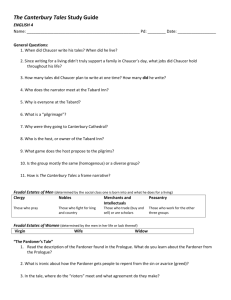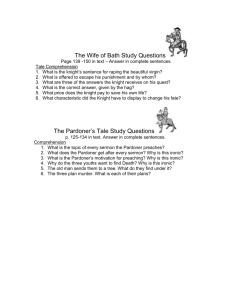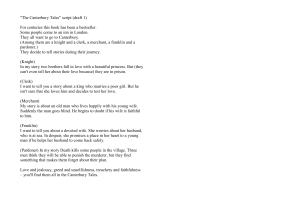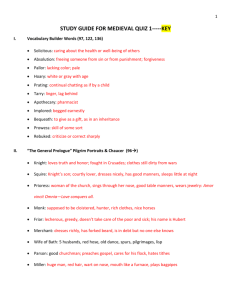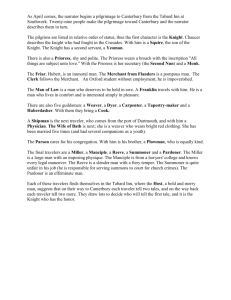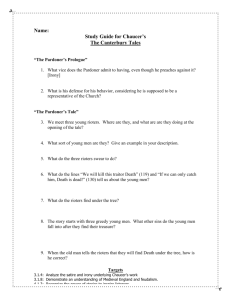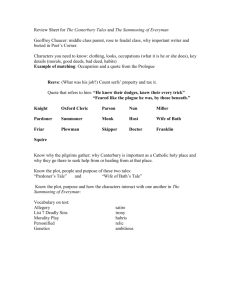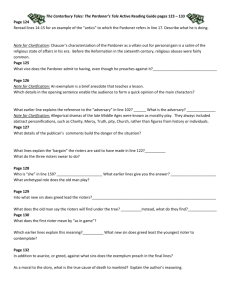The Canterbury Tales DISCUSSION QUESTIONS Directions: All
advertisement
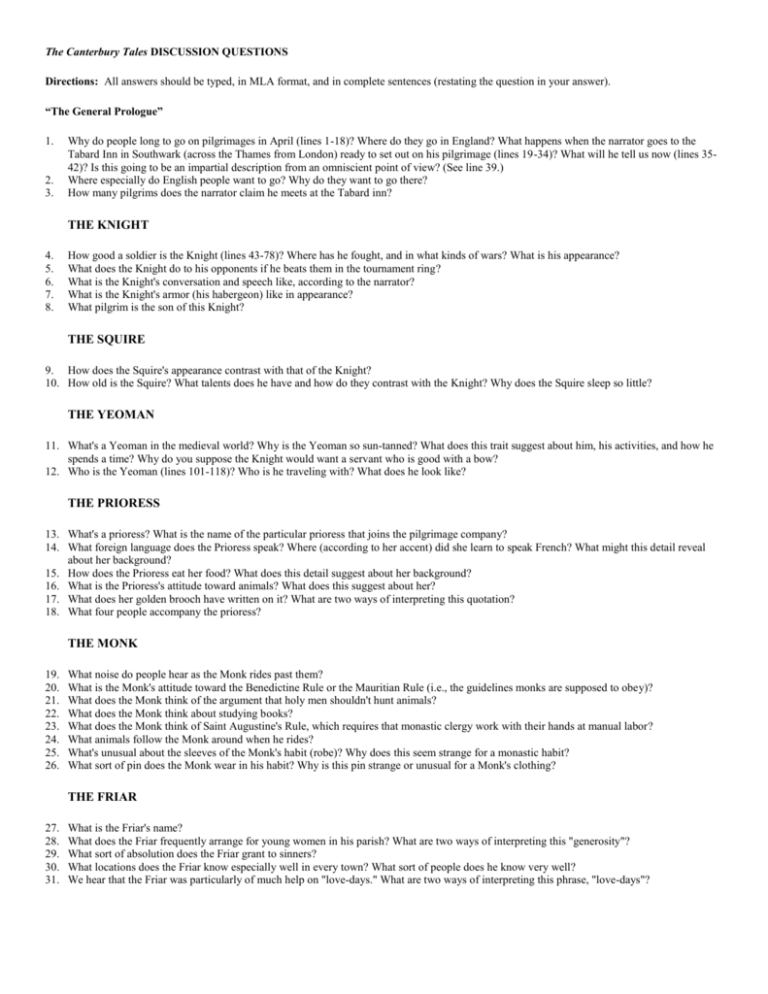
The Canterbury Tales DISCUSSION QUESTIONS
Directions: All answers should be typed, in MLA format, and in complete sentences (restating the question in your answer).
“The General Prologue”
1.
2.
3.
Why do people long to go on pilgrimages in April (lines 1-18)? Where do they go in England? What happens when the narrator goes to the
Tabard Inn in Southwark (across the Thames from London) ready to set out on his pilgrimage (lines 19-34)? What will he tell us now (lines 3542)? Is this going to be an impartial description from an omniscient point of view? (See line 39.)
Where especially do English people want to go? Why do they want to go there?
How many pilgrims does the narrator claim he meets at the Tabard inn?
THE KNIGHT
4.
5.
6.
7.
8.
How good a soldier is the Knight (lines 43-78)? Where has he fought, and in what kinds of wars? What is his appearance?
What does the Knight do to his opponents if he beats them in the tournament ring?
What is the Knight's conversation and speech like, according to the narrator?
What is the Knight's armor (his habergeon) like in appearance?
What pilgrim is the son of this Knight?
THE SQUIRE
9. How does the Squire's appearance contrast with that of the Knight?
10. How old is the Squire? What talents does he have and how do they contrast with the Knight? Why does the Squire sleep so little?
THE YEOMAN
11. What's a Yeoman in the medieval world? Why is the Yeoman so sun-tanned? What does this trait suggest about him, his activities, and how he
spends a time? Why do you suppose the Knight would want a servant who is good with a bow?
12. Who is the Yeoman (lines 101-118)? Who is he traveling with? What does he look like?
THE PRIORESS
13. What's a prioress? What is the name of the particular prioress that joins the pilgrimage company?
14. What foreign language does the Prioress speak? Where (according to her accent) did she learn to speak French? What might this detail reveal
about her background?
15. How does the Prioress eat her food? What does this detail suggest about her background?
16. What is the Prioress's attitude toward animals? What does this suggest about her?
17. What does her golden brooch have written on it? What are two ways of interpreting this quotation?
18. What four people accompany the prioress?
THE MONK
19.
20.
21.
22.
23.
24.
25.
26.
What noise do people hear as the Monk rides past them?
What is the Monk's attitude toward the Benedictine Rule or the Mauritian Rule (i.e., the guidelines monks are supposed to obey)?
What does the Monk think of the argument that holy men shouldn't hunt animals?
What does the Monk think about studying books?
What does the Monk think of Saint Augustine's Rule, which requires that monastic clergy work with their hands at manual labor?
What animals follow the Monk around when he rides?
What's unusual about the sleeves of the Monk's habit (robe)? Why does this seem strange for a monastic habit?
What sort of pin does the Monk wear in his habit? Why is this pin strange or unusual for a Monk's clothing?
THE FRIAR
27.
28.
29.
30.
31.
What is the Friar's name?
What does the Friar frequently arrange for young women in his parish? What are two ways of interpreting this "generosity"?
What sort of absolution does the Friar grant to sinners?
What locations does the Friar know especially well in every town? What sort of people does he know very well?
We hear that the Friar was particularly of much help on "love-days." What are two ways of interpreting this phrase, "love-days"?
THE MERCHANT
32. What sort of hat does the Merchant wear?
33. What sort of subject does the Merchant always talk about?
THE OXFORD CLERK
34. What does the Clerk of Oxford look like in terms of his physical build? What condition are his clothes in? What does this suggest about the
Clerk?
35. What does the Clerk apparently spend all his money on?
36. How talkative is the Clerk? When he talks, what traits characterize his speech?
37. What two things would the Clerk "gladly" do?
THE LAWYER
38. The lawyer (Sergeant-at-law) is capable of quoting what verbatim? How busy is the lawyer?
THE FRANKLIN
39. The Franklin is described in particular detail. What is his beard like? What color are his cheeks? (What modern legendary figure does he
resemble from our holiday season?)
40. What does it mean when the text reads the Franklin "was Epicurus' very son"? Who was Epicurus and what is Epicurean philosophy?
41. To what saint is the Franklin compared explicitly? Why is this an appropriate comparison?
42. What substances "snow" inside his house?
THE COOK
43. Who does the Cook apparently work for in the pilgrimage company?
44. What does the Cook have on his shin? What does this indicate about the Cook's health or hygiene?
THE SAILOR
45. What town is the sailor possibly from?
46. What does the Sailor keep on a cord around his neck? What does he keep "under his arm?" What does he keep hidden under his clothing {i.e.,
"and down")? Why do you suppose he keeps three of these items? What does it suggest about what sort of "sailor" this man is?
47. What does the Sailor steal while the traders on his boat are asleep?
48. If the Sailor gets involved in a naval battle, what does he do with the people he captures, according to the narrator? What does that mean?
49. What is the name of his vessel?
THE PHYSICIAN (DOCTOR OF PHYSIC)
50.
51.
52.
53.
54.
Why are the stars important for the Doctor’smedical treatments? (i.e., what "science" of the stars does the Doctor ascribe to?)
What profitable business arrangement does the Doctor have with "apothecaries"?
What sort of books is the physician well versed in?
What book does the physician not know very well?
What material does he like best of all as a "fine cordial"?
THE WIFE OF BATH
55.
56.
57.
58.
59.
What physical disability does the Wife of Bath have?
What does the Wife of Bath wear on her head? How much does this weigh? Why do you suppose she wears this?
How many husbands has she had?
What are two ways of interpreting that line about "not counting other company in youth"?
How many times had the Wife of Bath journeyed to Jerusalem? What other places has she traveled to? What do these wide travels suggest about
her as a character?
60. What are the Wife of Bath's teeth like?
61. What does the Wife wear on her feet/boots to help steer her horse? Why is this unusual for the period?
THE PARSON
62. What does the Parson do with his own income and goods?
63. Why does the narrator note that the Parson's parish was "wide" with "houses far asunder" before describing the Parson's travels? How does this
characterize the Parson?
64. What does the Parson do first before he teaches his flock?
65. Why does the Parson refuse promotion to London or Saint Paul's Cathedral?
THE PLOWMAN
66. To whom is the Plowman related? What sort of work does this Plowman do all day?
THE MILLER (ROBIN)
67.
68.
69.
70.
71.
72.
73.
What's the Miller like in terms of physical build?
The Miller has an usual party-trick. What technique does he use to remove a door from its hinges?
What color is his hair or beard? To what animals does the narrator compare this hair color?
What's unusual or disturbing about the Miller's nose?
We find out the Miller is good at jesting and "poetizing," but what's the only thing he writes/composes poetry about?
What does it mean when the speaker says the Miller had a "gold thumb?"
What unusual musical instrument does the Miller play? According to the last lines of the portrait, where does he apparently travel in the
pilgrimage order?
THE MANICPLE
74. What is a manciple? What apparently is the Manciple's attitude to "learned men" in comparison to his own wit?
THE REEVE (OSWALD)
75.
76.
77.
78.
79.
80.
How does the Reeve keep his hair and beard trimmed?
What is the Reeve's bodily build like, judging by the narrator's description of the Reeve's legs?
Why are business agents more afraid of the Reeve than they are afraid of death?
Before Oswald was a Reeve, what job did he have?
From what region of England does the Reeve come?
What position does the Reeve always ride in as he travels with the pilgrimage company? Why do you suppose he rides there?
THE SUMMONER
81.
82.
83.
84.
85.
What is a summoner?
What skin problems does Chaucer's Summoner have?
What foods does the Summoner like best?
What is the Summoner's mastery of Latin limited to?
Why does the narrator think the Summoner is a generous, friendly fellow? (i.e., For what trade would the Summoner let a person off easily when
that person was summoned to court?)
86. How had the Summoner gained power over all the boys and girls of the diocese?
87. What pilgrim in particular is a buddy to the Summoner and sings love-songs with him?
THE PARDONER
88.
89.
90.
91.
92.
93.
94.
95.
96.
What is a pardoner? What is a pardon or indulgence?
What is the Pardoner's hair like? What is this "Veronica" that the Pardoner has sewed to his cap?
What documents are stuffed full into the Pardoner's wallet?
What does the Pardoner's voice sound like?
What does the speaker mean when he states, "I think he [the Pardoner] was a gelding or a mare"?
What does the Pardoner claim about the pillow-case he carries?
What does the Pardoner claim about his bottle filled with pig bones?
What other fake relics does the Pardoner carry to sell?
When the narrator finishes listing the 29 pilgrims, what does he apologize about to the reader in lines 720-746?
THE HOST (HARRY BAILEY)
97. What traits distinguish the host?
GENERAL PROLOGUE CONTINUED:
98. What sport or entertainment does the Host suggest for the pilgrim company?
99. Describe the rules of the game the Host establishes. How many stories will each pilgrim tell on the way to Canterbury? How many stories will
each pilgrim tell on the way back to London?
100. What are the two criteria used to determine the best tale? What is the prize the best storyteller will receive? Where will the winner receive this
prize? Who will pay for it?
101. Who will judge the contest? According to the Host, if anybody "gainsays" or questions his rule, what will that person have to do along the
journey?
102. How does Harry Bailey (the Host) determine the order of the storytellers? Why is it suspicious that the Knight "happens" to draw first and
"happens" to win?
“The Miller’s Tale”
1.
2.
3.
4.
5.
6.
7.
8.
9.
10.
11.
12.
13.
14.
15.
16.
17.
18.
19.
20.
21.
22.
23.
24.
25.
26.
27.
28.
29.
30.
31.
32.
33.
34.
35.
36.
How do all the pilgrims reach to “The Knight’s Tale”? Which group especially thinks it is worth remembering?
Who does the host ask to tell the next tale?
Who interrupts the Host’s request?
What does the Miller say his tale will do to the Knight’s tale?
Who lives as a renter with John the Carpenter and his wife?
Who has John the Carpenter recently married?
How does John treat his young wife?
Describe Alison. Both her apparel and physical features.
What does Nicholas do while John is gone Osenye?
How does Alison initially respond to Nicholas’s advances?
What occupation does Absalon have?
After Absalon falls in lust with Alison, where does he go and what does he do with his guitar?
Who (besides Alison) reacts when Absalon plays this music?
What are some of the things Absalon does or sends to Alison to woo her after his serenading fails?
Nicholas’s plan to have his way with Alison involves three stages. During the first stage, between Saturday and Sunday, what does Nicholas
pretend to be?
When John finds Nicholas staring catatonically, what does he assume has happened to Nicholas?
What must John and his servant to do get inside Nicholas’s bedroom, since Nicholas is still pretending to be catatonic?
Nicholas, after a drink, says he will reveal to John special information. But if John tells anyone else, what does Nicholas say will happen to
John?
What does Nicholas say will happen next Monday, according to his astrological predictions?
Whom does John express concern about when he learns the world is going to end?
According to Nicholas, how long will the flood on Monday last?
What three objects does Nicholas order John to hang from the ceiling as emergency escape craft before the flood hits? What three people are
supposed to sit in the three tubs?
According to Nicholas, what will the only three survivors of this disaster be? What will they be lords of when the flood waters recede?
Who personally hand-builds three ladders to place beneath the three tubs?
What emergency food rations does John place in each tub?
What happens to John about 8:00 P.M. as he lies in the swaying boat waiting for the flood-waters?
Where does Nicholas sneak while John takes his nap?
Who notices that John hadn’t been out working all day? What does this person mistakenly assume about John’s whereabouts?
What does Absalon demand before he will go away?
What trick or prank does Alison play on Absalon?
What does Alison say before she slams the window shutters closed?
Who does Absalon seek out in the middle of the night to help him in his revenge?
What cunning plan backfires for Nicholas?
What does Nicholas cry out for when the hot poker burns him?
When John cuts the ropes and his tub falls, what injury does John suffer?
What prayer does the Miller make at the end of his tale?
“The Wife of Bath’s Tale”
37. At what age was the Wife of Bath first married?
38. How many husbands has the Wife of bath had?
39. What Old Testament figures does the Wife of Bath point to as evidence that various “righteous men” and “wise men” could have multiple
wives?
40. What does the Wife of Bath mean when she says, “if there were no seed sown, / Virginity—where then should it be grown?”?
41.
42.
43.
44.
45.
46.
47.
48.
49.
50.
51.
52.
53.
54.
55.
56.
57.
58.
59.
60.
61.
62.
63.
64.
65.
66.
67.
68.
69.
70.
What were her first three marriages like?
The Wife of Bath lists several complaints men typically make about women. What are some of these common complaints? (List three).
What made problems in the Wife of Bath’s fourth marriage?
What did the Wife of Bath do to make her fourth husband loyal?
What problems did the Wife of Bath have with her fifth husband?
What revelation does the Wife of Bath have about the tears she cried at her fourth husband’s funeral?
What sort of reading material did her fifth husband read to her each night before going to bed? How did the Wife of Bath react to this?
What did the Wife of Bath do to anger her husband?
How did she become dead in one ear?
What trick did she employ to sucker-punch her husband and knock him back into the fireplace?
How did she achieve mastery over the last husband, and what was their marriage like afterward?
During the reign of what mythic king is the tale set?
According to the Wife of Bath, why can’t people see elves anymore? What has driven them out of their natural habitat?
What happens to the maid riding alone through the corn?
What crime does the lusty bachelor commit?
What is the initial punishment ordered for the knight? Who intervenes and requests and special trial?
Who is in charge of this special trial for the knight?
What must the knight do to save his head?
How long does the Knight have to fulfill his mission? How is this similar or different than the time allotted to Sir Gawian in Sir Gawain and the
Green Knight?
What problem does the Knight find when he starts asking women what they want?
What strange sight does the knight see while riding through the forest on his return journey?
What do the twenty-four women do or what happens to them as the knight approaches?
What does the Old Hag say she wants in return for providing the answer to the knight’s riddle?
What is the Queen and the court’s reaction to the knight’s answer?
What are the wedding celebrations like when the knight marries the hag?
What does the hag teach the young knight about nobility in her lecture? What makes a person “noble” or “gentle”?
What defense does the hag provide for her poverty and her ugliness? Why are these advantages, according to her?
What two options does the hag present to the knight?
Which of the two does the knight choose?
How does the hag’s appearance change at the end of the story?
“The Merchant’s Tale”
71.
72.
73.
74.
75.
76.
77.
78.
79.
80.
81.
82.
83.
84.
85.
86.
87.
88.
89.
90.
91.
When the merchant speaks his opening lines, what does he declare he knows enough about?
What is the Merchant’s attitude toward his own wife?
What does the Merchant say would happen if his wife were coupled with the devil?
How long has the Merchant been married?
What region of Italy is the setting of “The Merchant’s Tale”?
How old is the Pavian knight? What is his marital status?
What is January’s attitude toward marriage?
What biblical basis does January point to to indicate that being married to a woman is a blessing?
What does Justinus think a husband should investigate before picking a wife?
What is Justinius’s own marriage like?
What is January’s reaction to Justinus’s quotations of Seneca?
Why does Januray set up a mirror in the market-place? What does he hope to watch covertly through the reflected images? How might the
mirror be symbolic?
What does Justinus suggest in contrast to January’s imagery of a wife being “heaven-on earth”?
Who does Justinus quote as an authority in marriage knowledge?
What happens to January each time he looks at May’s face during the wedding ceremony?
What is Damian’s job and his position in January’s court? What reaction does he have to May’s presence?
What does January drink before his wedding night?
When January kisses May, what do his beard hairs do?
When January sings a love song to May, what does the skin handing from his wrinkled neck do?
What does January immediately do after his “romantic” interlude?
What problem does Damian have?
92. What does January build, walled in with stones, as a little love-nest for himself and for May?
93. What two supernatural beings enjoy visiting this location?
94. What sudden physical handicap afflicts Janurary? How is this handicap symbolic?
95. After January suffers from this ailment, how does his treatment of May change?
96. What does May ask January to do to her if she is ever false or cheats on him?
97. Where does May indicate through sign language that Damian should go?
98. At the end of Pluto’s diatribe, he vows what?
99. When Prosperina hears Pluto’s vows, she makes her own vow. What does she say will happen even if January does catch May cheating?
100. What does May say she wants January to fetch her from the tree?
101. Why does January initially say he is unable to get one for her?
102. What solution does the couple come up with to allow May to gain access to the tree?
“The Pardoner’s Tale”
103. What is the setting of the tale?
104. List the sins the Pardoner condemns in the opening of his sermon and the historical or biblical figures he uses as examples.
105. When the Pardoner leaves his examples behind and turned to the rioters, he mentions their drinking habits. At what time of the day do these
guys show up at the tavern to drink?
106. What event disturbs them this morning as they try to drink?
107. What does the knave-boy reveal to them when they ask him to find out what’s going on?
108. Who killed the rioter’s friend?
109. What agreement or pact do the three rioters make with each other?
110. What is the old man’s appearance like?
111. What does the old man seek as he travels from place to place?
112. Where does the old man tell the rioters he last saw death?
113. What do the rioters find when they hunt there?
114. Explain how the rioters end up dying?
“The Nun’s Priest’s Tale”
115. What animals does Chaucer catalog as belonging to the poor widow?
116. Although the widow has gout, this doesn’t prevent her from doing what fun activity?
117. What is the name of the widow’s prize rooster?
118. There is no match in all the surrounding land for Chanticleer when it comes to one talent. What talent is that where he has no peer?
119. Chanticleer is obviously well-educated, how does he determine when it comes time to crow?
120. How many paramours does Chanticleer have?
121. What is the name of the fairest hen in the hen yard?
122. What power do birds and beasts have in the old days, according to the Nun’s Priest?
123. What nightmare does Chanticleer have that makes him groan and cluck in his sleep?
124. What is the beast that Chanticleer sees in his sleep?
125. What is Pertelote’s reaction to seeing her handsome knight, Chanticleer, terrified of a dream?
126. When Pertelote describes what wives want out of husbands, who is she quoting from earlier in The Canterbury Tales?
127. What figure from classical antiquity does Pertelote quote as an authority to prove that dreams are meaningless?
128. What remedy does Pertelote offer to “purge” Chanticleer of his nightmare?
129. In Chanticleer’s first story, where has the body been hidden? How does his companion learn of its location?
130. In the second story, the two travelers sailing by boat are warned in a dream about what? How does the dreamer react to this warning?
131. After “winning” the argument with Pertelote, what does Chanticleer assert about his fear of dreams?
132. The next day, how many times does Chanticleer “feather” Pertelote?
133. The Nun’s Priest compares the fox to Scariot, Genylon, and Green Synon. Explain these three allusions. Who is Judas Iscariot, Ganelon from
The Song of Roland, and Sinon from Homeric writings?
134. When Chanticleer first spies the fox, what does he do?
135. The fox comes up with a cunning lie. Why does he say he has come to see Chanticleer?
136. How does the fox get Chanticleer to stretch out his neck and close his eyes?
137. The fate of Chanticleer and the accompanying lamention is compared to the Iliad, the Aeneid, Hannibal’s attack on Rome and the Roman
destruction of Carthage, etc. What is the intended effect of applying this comparison to the possible death of a chicken?
138. What three humans chase the fox in an attempt to rescue Chanticleer? Who else joins the chase?
139. How does Chanticleer trick the fox into opening his mouth so Chanticleer can escape?
140. As soon as the fox opens his mouth, how does Chanticleer ensure he will not be easily seized again?
141. How does the fox attempt to lure Chanticleer down again?
142. What is Chanticleer’s response?
143. What effect does the Nun’s Priest’s tale have on Harry Bailey? How does he change in the way he addresses the priest?
